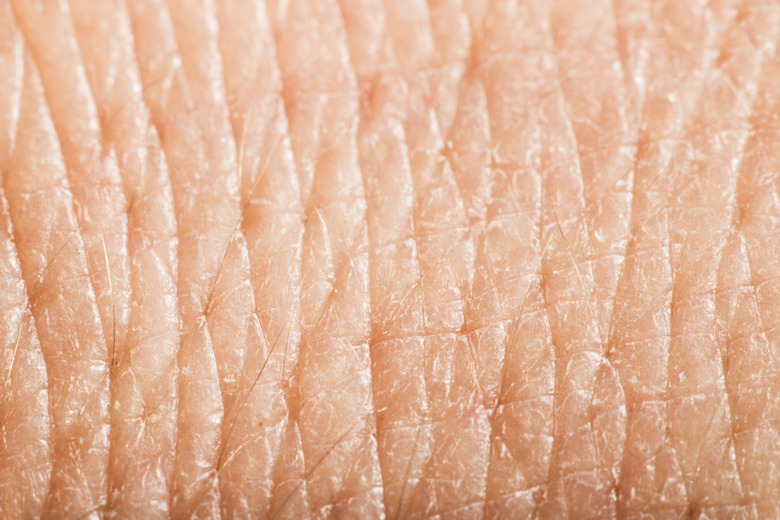What Is The Life Span Of Skin Cells?
Though it is often said that your body changes every seven years, this not completely accurate. While the human body is constantly in a state of regeneration, each type of cell has its own schedule. The human cell turnover rate differs based on location and function.
For instance, the stomach lining is constantly eroded by digestive acid and needs to be replaced every few days. On the other hand, it takes years for bones to be refreshed and in some body parts, such as the brain, many cells remain from the time of birth.
There are about 37 trillion cells in the adult human body, and almost 2 trillion of these divide each day. Most of these cells are somatic (non-reproductive) cells and divide through a process called mitosis, creating new cells identical to the parent cells.
TL;DR (Too Long; Didn't Read)
Since the human body loses about 50 million skin cells each day, they are constantly in a state of regeneration. The lifespan of skin cells is approximately four weeks.
The Body’s Largest Organ
The Body's Largest Organ
Though it is only a few millimeters thick at its thickest point, the skin is the body's largest organ and makes up about one-seventh of one's body weight. On average, it weighs between 7.5 and 22 pounds with a surface area of 1.5 to 2 square meters.
Since it is regularly exposed, it requires frequent cell regeneration. When you get a cut or scrape, skin cells divide and multiply, replacing the skin you have lost. Even without injury, skin cells routinely die and fall off. You lose 30,000 to 40,000 dead skin cells each minute, which is about 50 million cells every day.
Skin provides vital protection to all other organs. It also protects the body as a whole from harmful things such as excessive moisture, extreme temperatures, germs and toxins. Other functions include helping to regulate internal temperature and alerting the brain to various sensations such as itching and pain, sometimes preventing serious injury.
Three Levels of Skin
Three Levels of Skin
The epidermis, or outer layer, is the part you can see. It varies in thickness, depending on location. While it may be up to 4 millimeters thick on your feet and hands, it is often only 0.3 millimeters thick on places such as your eyelids, elbows and the back of your knees.
It is made up of dead skin cells that are firmly packed together and constantly shedding. The epidermis contains other types of cells that perform special functions. Melanocytes make and store _melanin_, which protects against the sun's UV rays. When skin is exposed to the sun, they produce more of this pigment, making your skin darker. Lymphocytes and Langerhans cells fight germs by "grabbing" them and taking them to the closest lymph node. Merkel cells are nerve cells that help sense pressure.
The dermis, or middle layer, is made up of a network of elastic collagen fibers that make the skin both strong and stretchy. The dermis is also home to a network of nerves and capillaries that help your body cool down. In some areas, the dermis extends into connective tissue, connecting the two. Of the three layers, the dermis has the most sensory cells and sweat glands.
The hypodermis, or deepest layer (also called subcutaneous or subcutis), is made up mostly of fat and connective tissue. Cavities in this layer are filled with storage tissue (fat and water) that acts as a shock absorber to bones and joints and also serves as insulation. This is where vitamin D is produced when skin is exposed to sunlight. Blood and lymph vessels, nerves, sweat, oil and scent glands and hair roots are also found at this level.
Lifespan of Skin Cells
Lifespan of Skin Cells
While we sometimes notice the shedding of old skin, most of the time these cells are too tiny to notice, and we are unaware we are leaving these traces of our DNA behind.
These departing cells are constantly being created in the lower layers of the epidermis before moving to the surface where they harden and fall off. This process of growing, moving and shedding takes about four weeks.
Skin Regeneration After Wounds
Skin Regeneration After Wounds
The process is more obvious when skin is lost due to a cut or other injury. While regrowth is similar to routine human cell regeneration, it has some extra steps.
First, collagen spreads to the wound area to create a framework that will support the new skin. Then, a network of blood vessels migrates to the area, followed by skin and nerve cells. Finally, the hair pigment, oil and sweat glands may regenerate.
If the wound is too deep, it may be missing some of these components and may not grow back properly; infection can slow the process. Even under the best circumstances, the new tissue produced often varies slightly from the original and results in a scar.
Cite This Article
MLA
Yavorski, Kimberly. "What Is The Life Span Of Skin Cells?" sciencing.com, https://www.sciencing.com/life-span-skin-cells-5114345/. 5 April 2019.
APA
Yavorski, Kimberly. (2019, April 5). What Is The Life Span Of Skin Cells?. sciencing.com. Retrieved from https://www.sciencing.com/life-span-skin-cells-5114345/
Chicago
Yavorski, Kimberly. What Is The Life Span Of Skin Cells? last modified March 24, 2022. https://www.sciencing.com/life-span-skin-cells-5114345/
